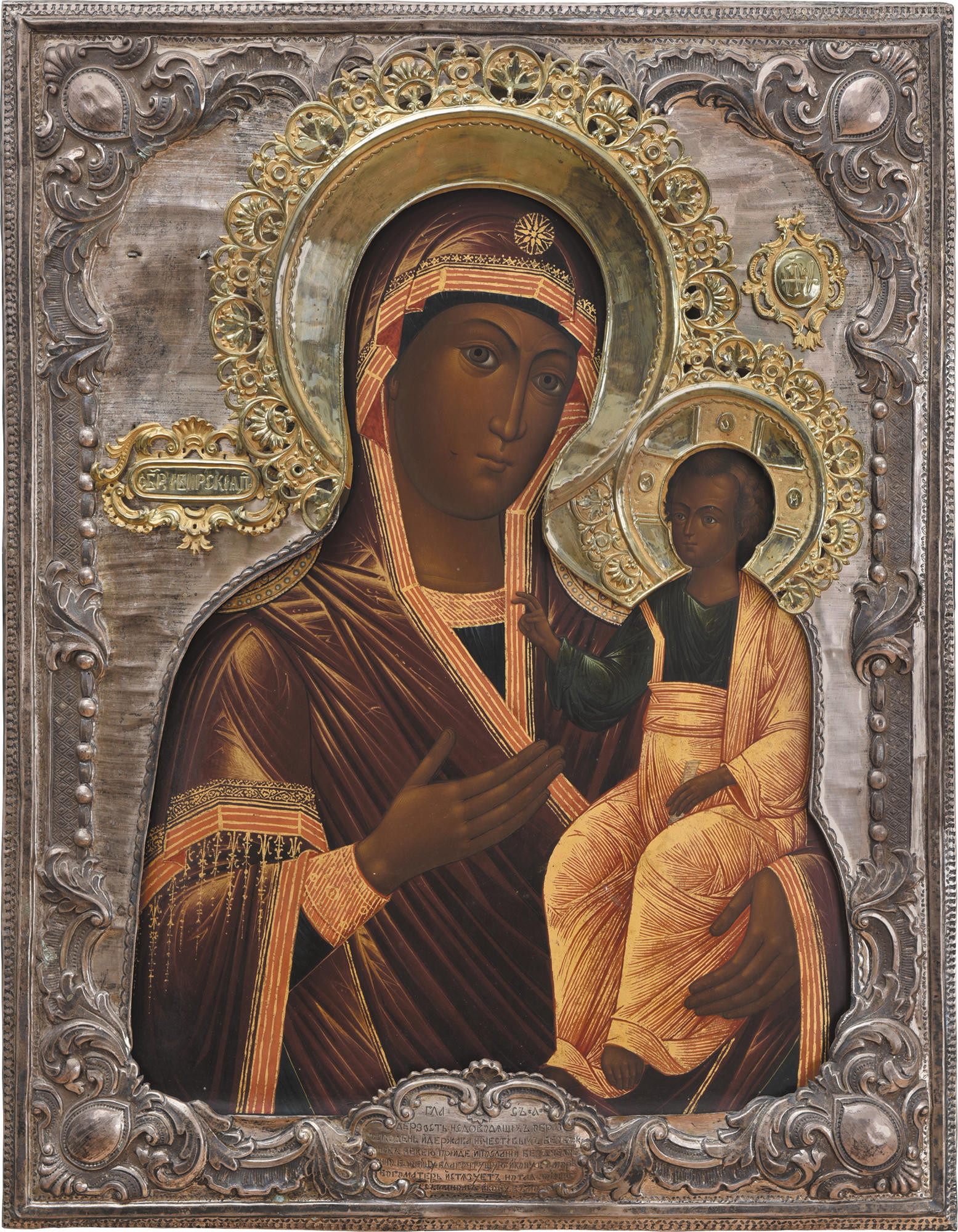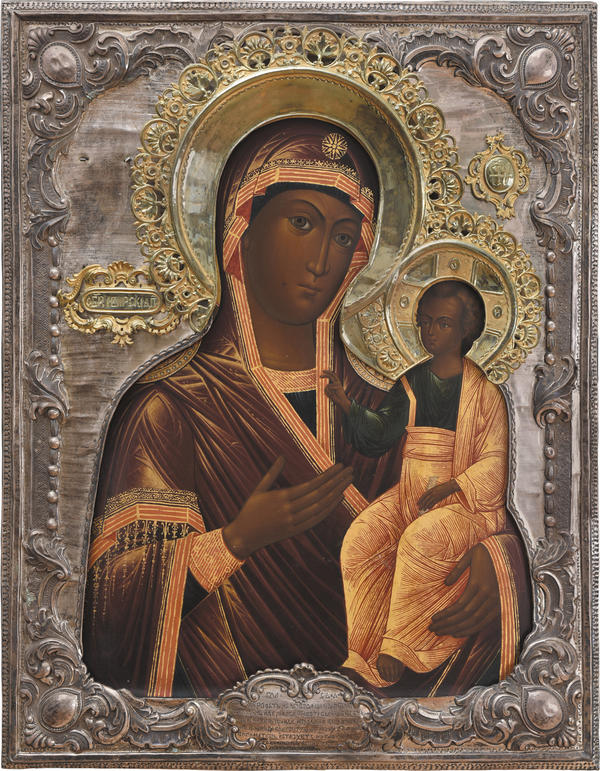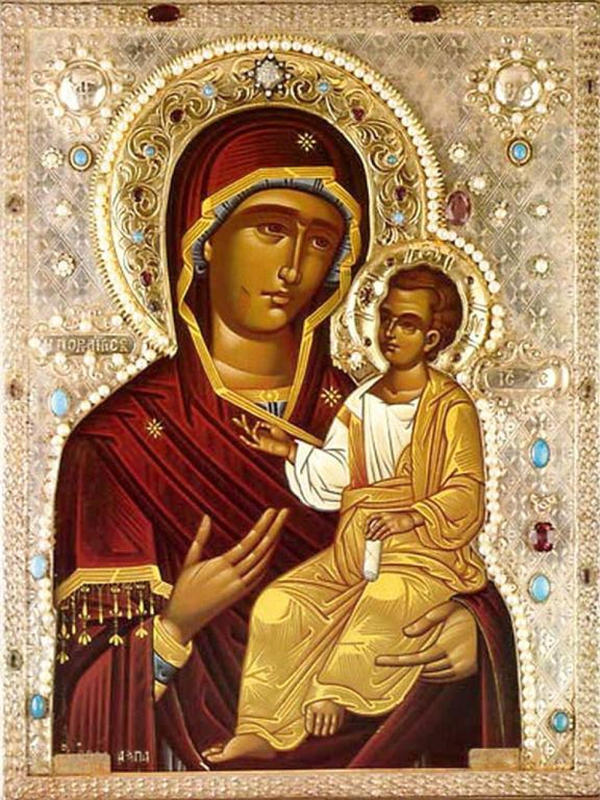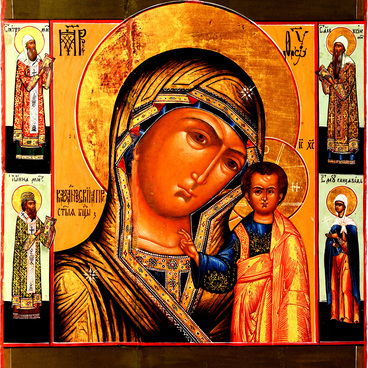Our Lady of Iveron is one of the versions of Hodigitria, a type of icon where the Virgin is depicted with the child Christ. Researchers date the most ancient icon of Our Lady of Iveron to the XI-XII centuries - it is located in the Iveron monastery on holy Mount Athos in Greece. In Rus (Russia), the story of this icon was depicted in the 1658 book ‘Mental Paradise’ devoted to the life of patriarch Nikon.
Our Lady of Iveron
Время создания
Second half of the XIX century
Размер
72x57,5 cm
72 x57.5 x 4.5 cm
72 x57.5 x 4.5 cm
Техника
Icon: wood (board with a cut-back centre portion), two opposite sunken keys. The canvas is not visible, levkas (primer), tempera and gilding. The covers: copper, silver plating, brass (the crowns, the cartouche), engraving, embossing, stamping, punching, mounting
Выставка
0
Открыть в приложении#3
Unknown Author
Our Lady of IveronOur Lady of Iveron
#2
#4
The icon from the Iveron monastery, the XI-XII centuries. Source: wikipedia.org
Rus’ (Russia) witnessed the iconoclasm - the movement against the Christian cult of icons in the IX century. At that time, as the legend goes, the image of the Virgin Mary was released into the sea near the city of Nikea. Many years later it appeared at the Iveron monastery. The icon was above the gate - so it was called “The Gatekeeper” or “The Goalkeeper” - and became the patroness of the monastery. Once, when the monastery was besieged by Saracens, an enemy arrow hit the icon and blood flowed out of the wound on her cheek.
#5
It is believed that this image was brought to Russia in 1648 by monk-priest Yamvlikh, who made a reproduction of the Athos of Our Lady of Iveron. The veneration of this type of icons began with the construction of the Iveron Chapel at the Resurrection Gates of Moscow’s Kitay-Gorod (Chinatown) in 1699 - there was a reproduction created by the tsar’s masters there.
The icon from the collection of the Orenburg Museum was created by Moscow masters in the second half of the 19th century. It presents a traditional image of Our Lady of Iveron: the head of the Virgin Mary is tilted slightly towards the seated Infant Christ; she is looking in front of her with her right hand raised in a prayerful and pointing gesture. Christ is depicted slightly turned to the left and holding a scroll of the Gospel in one hand, and giving a blessing with two fingers of his other hand.
#6
The Montreal Our Lady of Iveron, 1981. Source: wikipedia.org
One of the most famous contemporary depictions of Our Lady of Iveron is the so-called Montreal icon. It was created on Athos in 1981 by the Greek monk- priest Chryzostom, and the curator José Muñoz-Cortés brought it to Montreal in 1982. The image was revered as miraculous. When the keeper of the icon was killed in 1997, it disappeared without a trace. A year later, the Cathedral of St. Nicholas the Wonderworker in Montreal where the image had often been exhibited was completely burned down. The temple is now reconstructed with the services held there.
#7
The Orthodox Christians believe they should pray to Our Lady of Iveron for comfort in trouble, fires and other misfortunes. It is also believed that she can grant fertility, contribute to the replenishment of supplies and cure various diseases.
#8
Orenburg Regional Museum of Fine Arts
читать дальшескрыть
00:00
00:00
1x
Our Lady of Iveron
Время создания
Second half of the XIX century
Размер
72x57,5 cm
72 x57.5 x 4.5 cm
72 x57.5 x 4.5 cm
Техника
Icon: wood (board with a cut-back centre portion), two opposite sunken keys. The canvas is not visible, levkas (primer), tempera and gilding. The covers: copper, silver plating, brass (the crowns, the cartouche), engraving, embossing, stamping, punching, mounting
Выставка
0
Открыть в приложении
Поделиться





